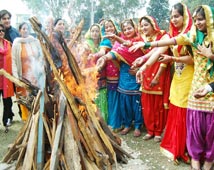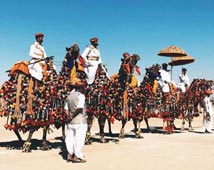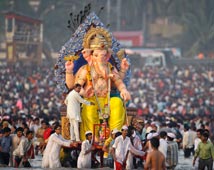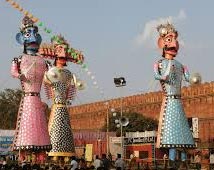
The zeal and the enthusiasm of the Tamilians come alive during the four day festival of Pongal which is the harvest festival of the Tamil Nadu. The Tamilians give it utmost importance. It is the biggest event of the year in Tamil Nadu. Pongal literally means "boiling over". The four day festival consists of Bhogi - Pongal, Surya -Pongal, Mattu -Pongal and Kanyapongal. The first day is devoted to the Rain God, Indran. The second day is celebrated in the honor of the Sun God Surya. In several places of Andhra Pradesh and Tamil Nadu, Jallikatu, a kind of bull fight is held. The third day is dedicated to honor and worship the cattle.

Id-ul-Fitr marks the end of Ramzan, the Muslim month of fasting. It is an occasion of feasting and rejoicing. Ramzan Id is celebrated on a day when the new moon appears. The faithful gather in mosques to pray, friends and relatives meet to exchange greetings. Prayers, family get-togethers and feasts are the major highlights of the celebrations. Idi or present of money are given to the youngsters by the family elders, conveying their blessings.
Holi is one of the most exuberant Hindu festival that brings the message of the onset of spring. It is the festival of colors and is celebrated by throwing colored water and powder on each other. Huge bonfires are lit on the eve of Holi as its symbolic representation. The festival of Holi is being celebrated since centuries with the same zeal and zest. It is a joyous celebration of the rejuvenation of nature, and renewed hope of happiness and peaceful coexistence. Especially famous is the Lathmaar Holi of Barsana and Nandgaon.

The desert festival celebrated in the golden city of Jaisalmer has an aura of its own. The festival becomes lively with legions of puppeteers, acrobats, and folk dancers add splashes of color. Camel races are of great significance and camel polo is a big attraction. The turban-tying competitions and the best-dressed Rajput contests add to this three day long festival.
Nagaur bustles with life during its annual cattle fair which is one of the largest in the country. Exciting games and camel races are part of the festivities. Owners of cattles from all over Rajasthan come and camp around the outskirts of Nagaur while they buy and sell animals. This fair is also famous for the various sports events that are organized in it, Tug-of-war, camel races and cockfights. At nightfall, folk music and songs bring out a magnificent musical touch to the quiet ambience of the desert.
This Christian festival marks the memory of the crucifixion of Jesus Christ. Just as it is celebrated around the world, Good Friday is observed in India, too, in April every year. All Christians attend Mass held in the churches on this day. Following Good Friday comes Easter Sunday, which is also celebrated with great enthusiasm and joy.
Easter commemorates the resurrection of Jesus Christ. It represents the victory of life over death. Easter is a celebration of Christ's resurrection from the dead.
Buddha Purnima, the birth anniversary of Lord Buddha, is celebrated by Buddhists all over India. But it is very popular in Sarnath and Bodhgaya. The Buddhists offer prayers in their temples on this day. The Buddha was born on a full moon day in the month of Vaisakh in 563 B.C. He achieved enlightenment as well as Nirvana on the same date.
Held on first 'Baisakh'- the 13th April - Baisakhi is one of Himachal's most important festival. Rooted in the rural agrarian tradition, it bids a final farewell to winter. The Sikhs celebrate this as a collective birthday, filling the atmosphere with gaiety, music, dancing and good cheer. This festival is an opportunity in villages to enjoy with sheer abandon because they know that a season of hard work follows soon after which is the time for harvesting corn and other grains.
This Rajasthani festival is celebrated by the women, on the third day of the moonlit fortnight of Shravan, in memory of Goddess Parvati’s departure to her husband’s home. Besides Rajasthan this festival is also celebrated in Bihar and Uttar Pradesh. In the morning Puja is performed. Later, in the evening Young ladies and girls dressed up in lehengas and chunaris to perform dandia dances.
Raksha Bhandan is celebrated on the full-moon day in the month of Sravana (July-August). The festival of Raksha Bandhan symbolizes love, affection and the feeling of brotherhood. On this day, sisters tie an amulet, the Rakhi, around the right wrist of their brothers praying for their long life and happiness. Raksha means protection, and in some places in medieval India, where women felt unsafe, they tied Rakhi round the wrists of men they could count upon, regarding them as brothers. The tradition of tying a thread or "rakhi" around the wrist to convey different feelings has been coming down through the ages since the Vedic times.
Nag Panchami is observed on the 5th day of the bright half of Shravan (July-August). On this day nag, cobras and snakes are worshipped with milk, sweets, flowers, lamps and even sacrifice. The image of Nag deities made of silver; stone, wood are first bathed with water and milk, and then worshipped with the reciting of the mantras.

This day is dedicated to the Lord Ganesha, the elephant-headed god of all good beginnings and success. Held annually, this festival is a ten day long event. The images of Lord Ganesha are installed and worshipped and on the last day these are taken in processions to be immersed in flowing water. The seafront at Mumbai, packed with people, is a spectacular sight.
Kerala's most important festival is celebrated in the honor of the ancient asura king Mahabali. The occasion also heralds the harvest season. The decorating of houses with carpets of flowers, a sumptuous lunch and songs in praise of the golden reign of Mahabali, mark the ten day long festivities. A major attraction of the Onam celebrations is the famed snake boat races along the backwaters at Champakulam, Aranmula and Kottayam.
Janmashtami, the birth of lord Krishna is celebrated with great devotion and éclat on the Ashtami of Krishna Paksh or the 8th day of the dark fortnight in the month of Bhadon, in the whole of north India. Raslila, a tableaux depicting scenes from Krishna's life especially the love for Radha, is performed. In the evening, bhajans are sung, which end at midnight, the auspicious moment when lord Krishna was born. Thereafter, arti is done, prasad distributed and flowers showered on the idol.
Muharram is the opening month of the Hijra year. The 10th day of this month (May) is honored by the Muslims of Kerala. Muharram marks the martyrdom of Imam Hussain, grandson of Prophet Mohammed. Taziyas which are bamboo and paper replicas of the martyr's tomb, adorned with mica are carried throughout the streets of the city. The tragedy is expressed by mourners by beating their breasts and grieving over the murder of the Imam accompanied by drum beats. Fasting is an important ritual of this day.

Dussehra or Vijay Dashmi is a very popular Hindu festival, celebrated with éclat throughout the country. It is observed on the tenth day of the bright halk of Ashvin (September-October). It is a ten-day celebration, commemorating the victory of Lord Rama over the demon king, Ravana. ‘Ramlila’ which is based on the epic story of Ramayana, is staged at various places in most of the cities and towns in northern India. During this performance the Ramayana is constantly recited accompanied by music. It presents a fine blending of music, dance, mime, and poetry before an enthusiastic and religious audience sharing every event of the story with the actors.
During this festival sermons are delivered in mosques by learned men, focusing on the life and noble deeds of the Prophet who was born on the twelfth day of Rabi-ul-Awwal, the third month of the Muslim year. The word 'barah' stands for the twelve days of the Prophet's sickness. In some parts of the country, a ceremony known as 'sandal' rite is performed over the symbolic footprints of the Prophet engraved in stone.
Diwali, the festival of lights, falls on 'Amavasya', the darkest night of 'Kartika'. It symbolizes the victory of good over evil and the lifting of the spiritual darkness that envelops the soul. The festival commemorates Lord Rama's return to his kingdom, Adyodhya after completing his 14 years of exile. The word Deepawali which means rows of lighted diyas (earthen lamps), brings a glow to the humblest home or the grandest houses. Sweets and gifts are exchanged between families and friends amidst the bursting of crackers. Doors are left open on Diwali for Goddess Laxmi. The festive occasion also marks the beginning of the Hindu New Year.
This lovely and gigantic fair falls on the last day (Full Moon Day) of the Hindu month of Kartik (Oct – Nov) near the sacred lake of Pushkar. This beautiful lake surrounded by bathing ghats, has its religious significance, rooted in a myth. The fair is primarily dedicated to Lord Brahma, the creator and one of the holy trinity. The colorfully dressed people enhance the exuberant mood of the fair.

This celebration in honor of the goddess, the mother of the world, begins on the first day of Ashvin, and goes on for nine days. The goddess is the personification of Power, or “Shakti”. She is known by many names: “Kali”, “Laxmi”, “Sarasvati”, “Chandi-ka”, “Durga”, “Bhavani”, “Ambika”, “Ashtabhuja” (eight hands). Her main task is to punish the wicked. She is engaged in war, and weapons are in her hands. She sits on a lion. Her weapons are the “shul” (pike), “chakra” (wheel), “parshu” (axe) and “talvar” (sword). Kali is known as “Mahisha-surmardini”, the slayer of the demon Mahishasur. The fight against the demon begins on the first day until he is defeated on the ninth day. VAIKUNTH EKADASHI There are in all 24 Ekadashis observed by Hindus during the year.
Christmas is celebrated in India with great fervor. All the major Indian cities wear a festive look. Christmas parties launch off celebrations for the New Year, thus retaining the festive mood for at least a week. Shops and bazaars are decorated for the occasion and offer attractive bargains. Carol singing, get-togethers and the exchanging of gifts enhance the Christmas spirit.
| ------------------ Recommended Fairs & Festivals Tours ------------------ | ||||||
|